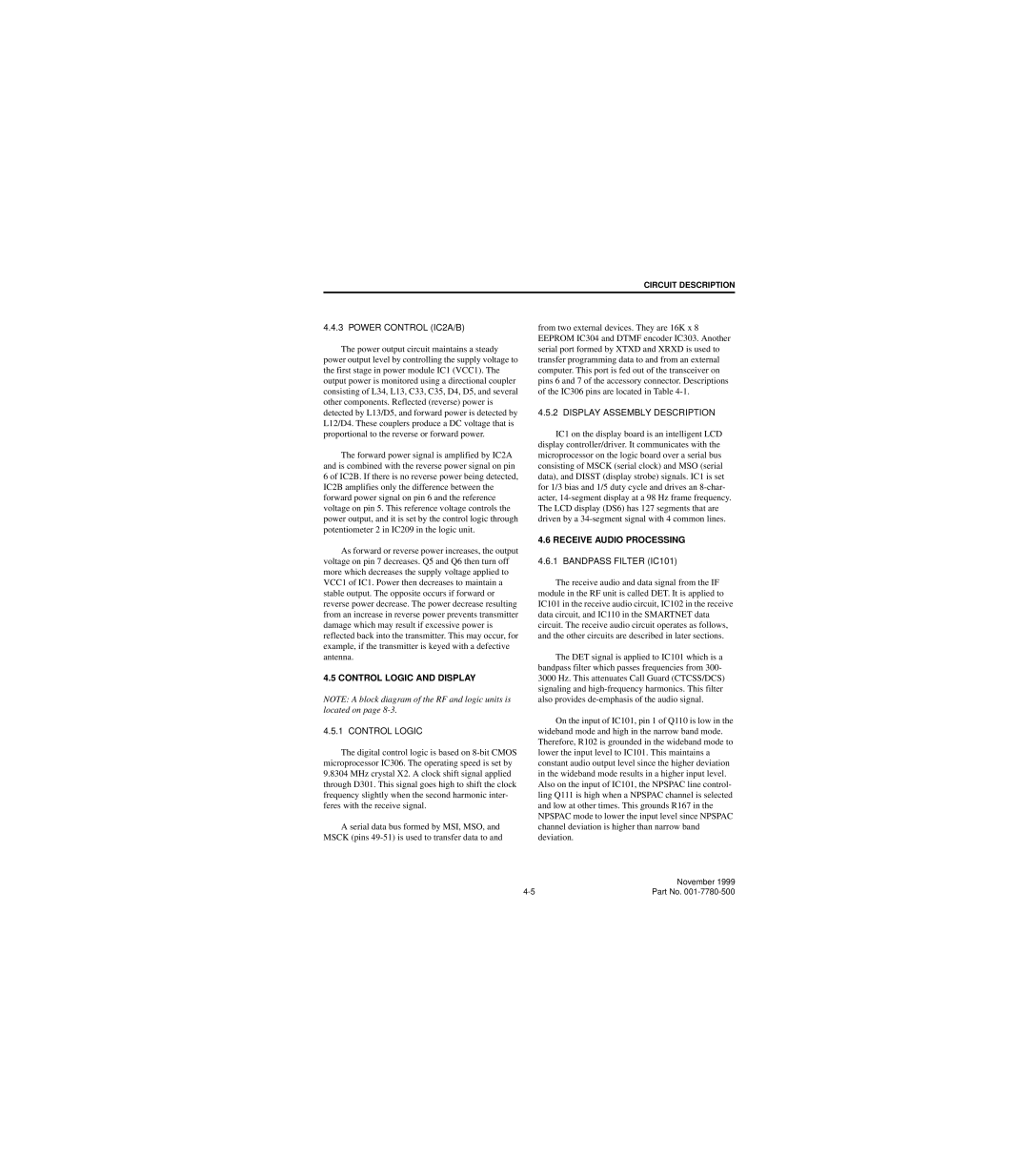CIRCUIT DESCRIPTION
4.4.3 POWER CONTROL (IC2A/B)
The power output circuit maintains a steady power output level by controlling the supply voltage to the first stage in power module IC1 (VCC1). The output power is monitored using a directional coupler consisting of L34, L13, C33, C35, D4, D5, and several other components. Reflected (reverse) power is detected by L13/D5, and forward power is detected by L12/D4. These couplers produce a DC voltage that is proportional to the reverse or forward power.
The forward power signal is amplified by IC2A and is combined with the reverse power signal on pin 6 of IC2B. If there is no reverse power being detected, IC2B amplifies only the difference between the forward power signal on pin 6 and the reference voltage on pin 5. This reference voltage controls the power output, and it is set by the control logic through potentiometer 2 in IC209 in the logic unit.
As forward or reverse power increases, the output voltage on pin 7 decreases. Q5 and Q6 then turn off more which decreases the supply voltage applied to VCC1 of IC1. Power then decreases to maintain a stable output. The opposite occurs if forward or reverse power decrease. The power decrease resulting from an increase in reverse power prevents transmitter damage which may result if excessive power is reflected back into the transmitter. This may occur, for example, if the transmitter is keyed with a defective antenna.
4.5 CONTROL LOGIC AND DISPLAY
NOTE: A block diagram of the RF and logic units is located on page
4.5.1 CONTROL LOGIC
The digital control logic is based on
A serial data bus formed by MSI, MSO, and MSCK (pins
from two external devices. They are 16K x 8 EEPROM IC304 and DTMF encoder IC303. Another serial port formed by XTXD and XRXD is used to transfer programming data to and from an external computer. This port is fed out of the transceiver on pins 6 and 7 of the accessory connector. Descriptions of the IC306 pins are located in Table
4.5.2 DISPLAY ASSEMBLY DESCRIPTION
IC1 on the display board is an intelligent LCD display controller/driver. It communicates with the microprocessor on the logic board over a serial bus consisting of MSCK (serial clock) and MSO (serial data), and DISST (display strobe) signals. IC1 is set for 1/3 bias and 1/5 duty cycle and drives an
4.6 RECEIVE AUDIO PROCESSING
4.6.1 BANDPASS FILTER (IC101)
The receive audio and data signal from the IF module in the RF unit is called DET. It is applied to IC101 in the receive audio circuit, IC102 in the receive data circuit, and IC110 in the SMARTNET data circuit. The receive audio circuit operates as follows, and the other circuits are described in later sections.
The DET signal is applied to IC101 which is a bandpass filter which passes frequencies from 300- 3000 Hz. This attenuates Call Guard (CTCSS/DCS) signaling and
On the input of IC101, pin 1 of Q110 is low in the wideband mode and high in the narrow band mode. Therefore, R102 is grounded in the wideband mode to lower the input level to IC101. This maintains a constant audio output level since the higher deviation in the wideband mode results in a higher input level. Also on the input of IC101, the NPSPAC line control- ling Q111 is high when a NPSPAC channel is selected and low at other times. This grounds R167 in the NPSPAC mode to lower the input level since NPSPAC channel deviation is higher than narrow band deviation.
| November 1999 |
Part No. |
